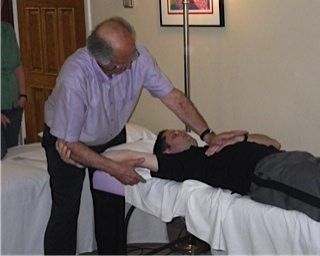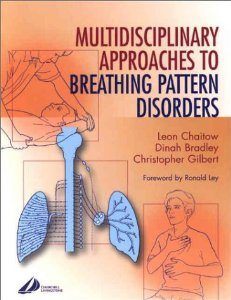
Below is summary of some of the main points of the course that I thought would be worth sharing. These are all direct statements from the workshop and are from his textbook on Breathing Pattern Disorders if you want to learn more or see some of the efficacy and references.
What is a Breathing Pattern Disorder?
- While 10% of patients in the US have diagnosed hyperventilation syndrome, far more people have a more subtle, yet likely clinically significant, breathing pattern disorder that involves being in a constant state of inhalation.
- This leads to hypocapnia – the deficiency of carbon dioxide in the blood due to hyperventilation, leading to respiratory alkalosis, and eventually hypoxia or the reduction of oxygen to tissue
- This is commonly seen in chest breathers, that essentially never fully exhale and utilize all of their lung capacity.
- This essentially puts an individual in a sympathetic state and a subtle, yet fairly constant state of fight-or-flight
- This can lead to changes in anxiety, blood pH, muscle tone, pain threshold, and many central and peripheral nervous system symptoms. Some even mimicking cardiac problems.
- Some of the most interesting info I learned were related to two studies that document the correlation between breathing and some of our daily activities.
- In one, the study examined typing on a keyboard and showed that EMG activity of the scalenes and trapezius increased and thorax and abdominal activity decreased while typing. Perhaps this is a primitive reflex but it causes us to breathe more shallow, with less diaphragm, and with more upper chest and neck. Since we all likely spend a good chunk of our day typing, this is very prevalent.
- In another, the study showed that people held their breath, increased their respiratory rate, and experienced sympathetic arousal when sending AND receiving text messages.
How to Assess Breathing Pattern Disorders
- High scores on the Nijmegan questionnaire have been shown to be both sensitive and specific for detecting people with tendencies consistent with breathing pattern disorders.
- Observe breathing patterns
- Breath Holding – People can normally hold their breath between 25 and 30 seconds. If less than 15 seconds may mean low tolerance to carbon dioxide.
- Supine Breathing Hi-Low Test – Hands on chest and stomach, breathe normal – what moves first? What moves most? Looking for lateral expansion and upward hand pivot.
- Breathing Wave – Lay prone, breathe normal, spine should flex in a wave-like pattern towards head. Segments that rise as a group may represent thoracic restrictions.
- Seated Lateral Expansion – Place hands on lower thorax and monitor motion while breathing. Looking for symmetrical lateral expansion. This is what expansion should look like:
- Assessment of elevated and depressed ribs and clavicle.
- Assessment of poor movement patterns.
Manual Therapy for Breathing Pattern Disorders
- Based on your assessment, there are several manual therapy techniques that can be performed.
- Leon is a big advocate for treating muscles that have increased tone or activity with muscle energy technique (MET). Big areas to watch out for include psoas, QL, latissimus, upper trap, scalene, and SCM
- Leon showed some MET techniques for the diaphragm, elevated ribs, and depressed ribs, as well as techniques to work on thoracic mobility.
- Other techniques used include positional release, trigger point release, and Leon’s integrated neuromuscular inhibition technique, which is essentially a combo.
- Lastly, not a manual technique but pursed lip breathing, which has been shown to relieve dysponia, slow respiratory rate, increase tidal volume, and restore diaphragmatic function.
- Obviously there was a lot more. I definitely recommend picking up Leon’s book on Breathing Pattern Disorders for more info on all these techniques.
Some Take Home Thoughts for Me
- Our daily posture and habits are feeding into subtle breathing pattern disorders in most of our society, this is probably more prevalent than we realize
- We all have those patients that I always refer to as always in “constant tone” and suffering from neck pain, shoulder pain, and headaches. I am going to start here first and then see what self-corrects with just some breathing techniques before jumping right in.
- I also have a different outlook on people with chronic and uncharacteristic pain, perhaps breathing patterns disorders is a factor?
- This definitely correlates with a lot of our emerging understanding of neuroscience. But perhaps our brain’s response is being change by our breathing patterns?
[hr]





